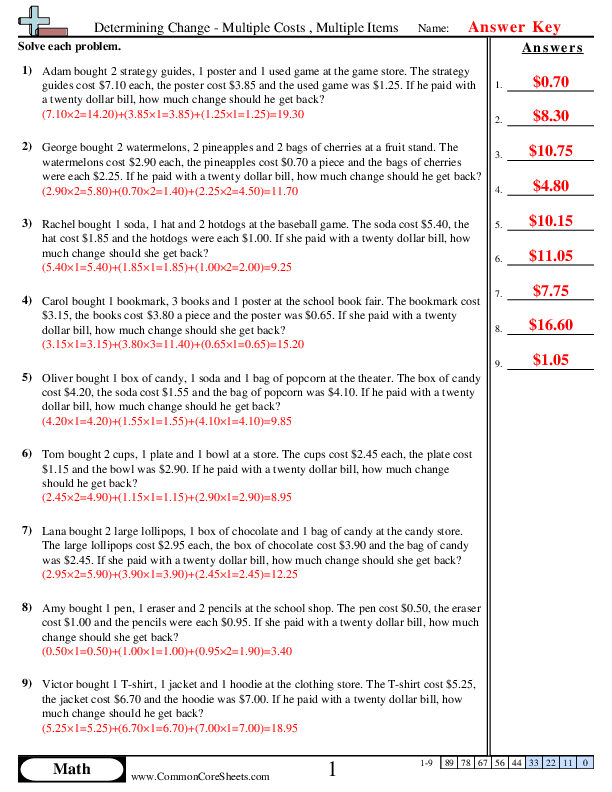Money worksheets are a great tool for teaching kids how to identify and add or subtract money. Our money worksheets are the best on the internet and are perfect for kids in elementary school. With a variety of fun and engaging activities, these worksheets will help kids learn about counting coins, making change, and identifying currency. The best part is that they are all free to download and print. These money worksheets are a must-have resource for any teacher. So why wait? Download our free money worksheets today and give your kids the skills they need to succeed with money!
Browse Sheets By Problem Type
×
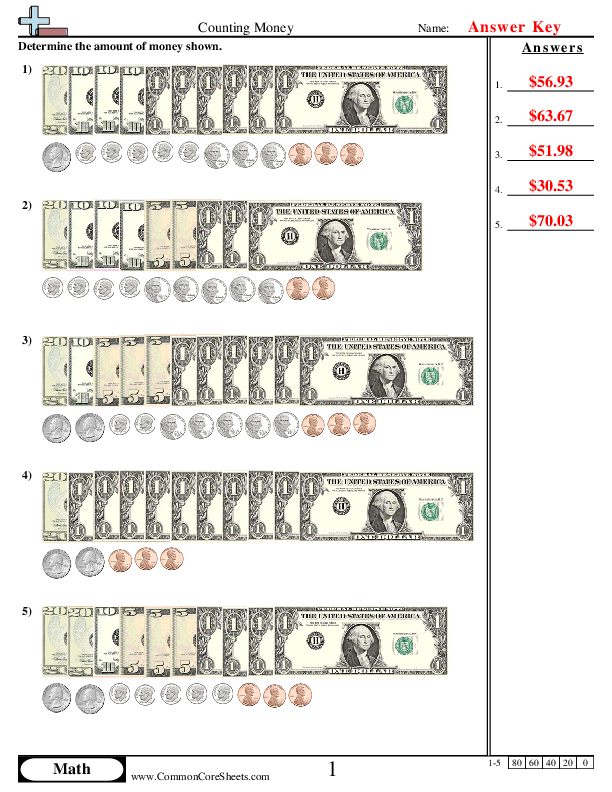
Counting Money (with change)


×
Description:
"This worksheet is designed to enhance children's understanding of mathematics, specifically the vital skill of counting money. It engages learners with five interesting math problems, encouraging practical application and mastery of the subject. Adaptable for individual needs, the content can be customized, morphed into handy flash cards, or incorporated efficiently into distance learning programs. A versatile and interactive tool for effective learning."

×
Student Goals:
Improved Understanding of CurrencyAfter completing the 'Counting Money' worksheet, students should have an improved understanding of the concept of currency. They will learn about the different denominations such as pennies, nickels, dimes, quarters, and dollar bills. By identifying and counting coins and notes, they will understand the difference in their values and why it is vital in monetary transactions.Enhanced Mathematical SkillsThis math worksheet will also help students enhance their basic mathematical skills. They will improve their capability to perform basic arithmetic operations involving money such as addition, subtraction, and possibly multiplication and division. It would further solidify their foundation in maths and provide them with the practical application of these operations in a real-world context, ultimately making numbers more meaningful and manageable.Real-world ApplicationLearning to count money effectively is not only a fundamental mathematical skill, but it also has numerous practical, real-world applications. This exercise will enable students to apply theoretical mathematical concepts to everyday situations such as shopping or saving, thereby bolstering their life skills and preparing them for independent living.Enhanced Problem-solving AbilitiesThrough these exercises, students will enhance their problem-solving abilities. They will learn to apply reasoning to calculate total amounts, make change, compare totals, and determine whether enough money is available for particular transactions. This nurturing of problem-solving skills at a young age potentially primes them for tackling more complex challenges as they advance in their schooling.Boosted ConfidenceUpon completion of the 'Counting Money' worksheet, students will likely experience a boost in their self-confidence. The mastery and understanding of how to count money will give them the confidence to handle money in real-world scenarios. Consequently, the accomplishment can foster a feeling of self-reliance and competence in their mathematical abilities and practical life skills.


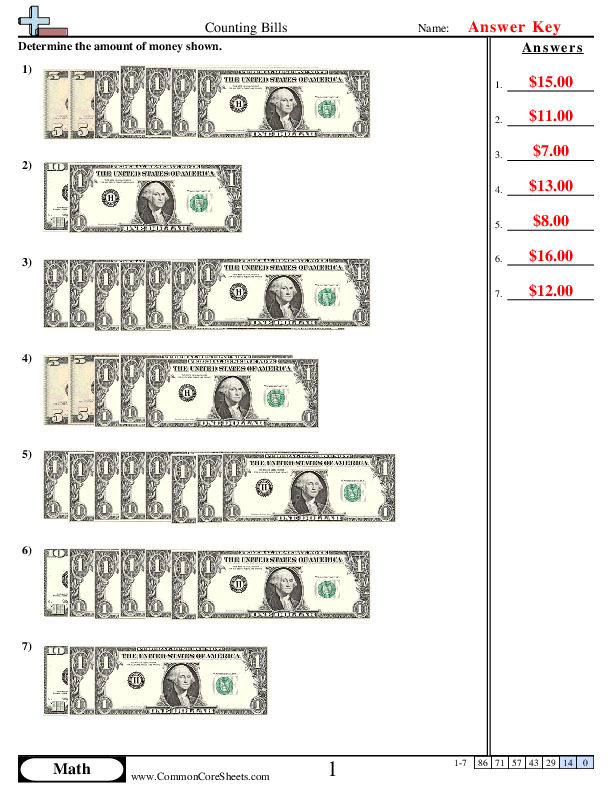
Counting Bills


×
Description:
"This worksheet is designed to enhance children's mathematical skills with a focus on counting bills. Consisting of 7 uniquely designed problems, this math worksheet encourages critical thinking and problem-solving. Capable of being customized to suit individual needs, this tool can also be converted into flash cards for an engaging and effective learning experience. It accords well with distance learning, making mathematical concepts approachable and fun, regardless of the learning environment."

×
Student Goals:
Math Skill EnhancementUpon finishing the 'Counting Bills' worksheet, students will have substantially advanced their numerical capabilities. Activities in the worksheet are designed to synchronize mathematical proficiency with real-world applications, thereby fostering relevance and interest.Critical Thinking DevelopmentThis worksheet encourages critical thinking and rationalization. By having to navigate through different problems involving bills counting, students will develop an ability to apply logic and systematic reasoning to solve practical situations.Improved Problem-solving SkillsThe act of deciphering the problems provided in the worksheet is a fantastic way to improve problem-solving skills. Students will learn to identify mathematical problems related to bills counting, establish appropriate strategies to solve them, and finally, execute the chosen approaches successfully.Enhanced Speed and AccuracyThrough consistent practice with the 'Counting Bills' worksheet, students will enhance their speed and accuracy in solving math problems. This improvement enables them to complete their examinations under timed conditions efficiently, thereby boosting their overall academic performance.Money ManagementThe 'Counting Bills' worksheet is an effective tool in initiating young learners into the fundamentals of money. The regular interaction with bills counting problems will familiarize the pupils with the basic tenets of money management, an essential skill in their adult life.Grasping the Value of MoneyBy learning to count bills through this worksheet, students gain a meaningful understanding of the value of money. They become more conscious of the worth of different bill denominations, fostering responsibility in spending and saving.Building Confidence in MathLast but not least, by navigating through the practice problems successfully, children will build a solid confidence level in their math skills. This boost in self-confidence can significantly reduce math anxiety, promoting positive attitudes towards learning math and overall academic success.



Counting Change (within a dollar)


×
Description:
"This worksheet is designed to reinforce kids' math skills in understanding currency and counting change under a dollar. It offers 10 problems that explore practical applications, priming them for real-world financial literacy. It's flexible, supporting customization, transformation into flashcards, or adapting to distance learning scenarios. Essential for honing math prowess!"

×
Student Goals:
Mathematical Skills DevelopmentUpon finishing the Counting Change worksheet, students would have developed an enhanced understanding of basic monetary values and computations. They will get smarter in counting money, more specifically, coins available within a dollar. This will not only help in reinforcing their number recognition skills but will also promote the application of arithmetic operations in practical, real-world scenarios.Number Sense ImprovementBy mastering the task of counting change within a dollar, students further strengthen their number sense, a critical aspect of early mathematics learning. Improved number sense leads to their better grasp of number relationships, promotes the understanding of numerical magnitude, and allows them to perform mental math more proficiently.Problem-Solving Ability EnhancementAs the worksheet incorporates problems requiring them to calculate and verify amounts, it provides an opportunity to enhance their problem-solving skills. This improvement in problem-solving abilities aids their academic development, forming the cornerstone for more complex future learnings in mathematics and other STEM-related subjects.Knowledge Application in Real-life SituationsThe Counting Change worksheet stimulates students' minds to apply learned math concepts practically. As they tackle this exercise, students will get equipped with essential money management skills required in the real world. They will become more competent in handling money, ensuring the correct calculation of change during financial transactions, and fostering the beginning of financial literacy.Boosted Confidence and Independent LearningAfter successfully completing the worksheet, students will experience a surge in their confidence levels. The feeling of accomplishment when solving a problem independently reinforces self-assurance and encourages self-driven learning. They will begin to tackle new problems with a positive mindset, fostering a rounded development of mathematical proficiency and ensuring continued academic progress.


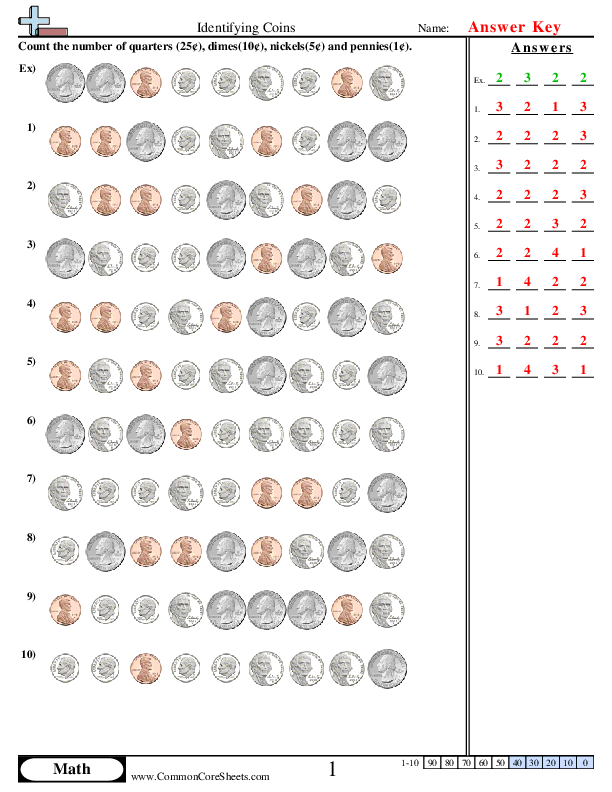
Identifying Coins


×
Description:
"This worksheet is designed to boost children's math skills by focusing on identifying coins. It includes 10 engaging problems that encourage students to recognize and differentiate various currency. Tailorable to the unique needs of each child, the worksheet can be modified, transformed into flash cards, or integrated into distance learning curriculums to further reinforce their learning and understanding of basic monetary concepts."

×
Student Goals:
Recognize and Differentiate CoinsStudents should be able to distinguish among different types of coins such as penny, nickel, dime, and quarter. Recognizing the coins by their color, size, and design is critical for their understanding of money in a broader sense. This recognition also enhances their visual perceptual skills.Understand Value of CoinsAfter completing this worksheet, students should comprehend the different monetary values represented by each coin. They should understand that despite its size, a dime expresses more value than a nickel and that the value of a quarter is more than that of a penny, nickel, or dime. This comprehension will significantly aid their mathematical and practical life skills.Perform Basic Money MathThis worksheet will equip students with the ability to perform basic math operations using coins. This involves adding or subtracting coins to obtain a certain value or figuring out how many of a certain coin make up a specific value. It's a practical way to begin understanding and performing arithmetic operations.Apply Real-Life ScenariosChildren should be capable of applying what they've learned from the worksheet to real-world situations. They should be able to understand the practical usage of coins while buying goods, comparing prices, or deciphering change owed. This functional application reinforces their understanding, practicality, and the importance of learning about coins.Build Confidence with Money ManagementAdditionally, becoming familiar with money and how it works builds confidence in children. It introduces them to the concept of money management at an early age and aids in their journey of developing financial literacy. Understanding coins is the first step towards this crucial life skill.


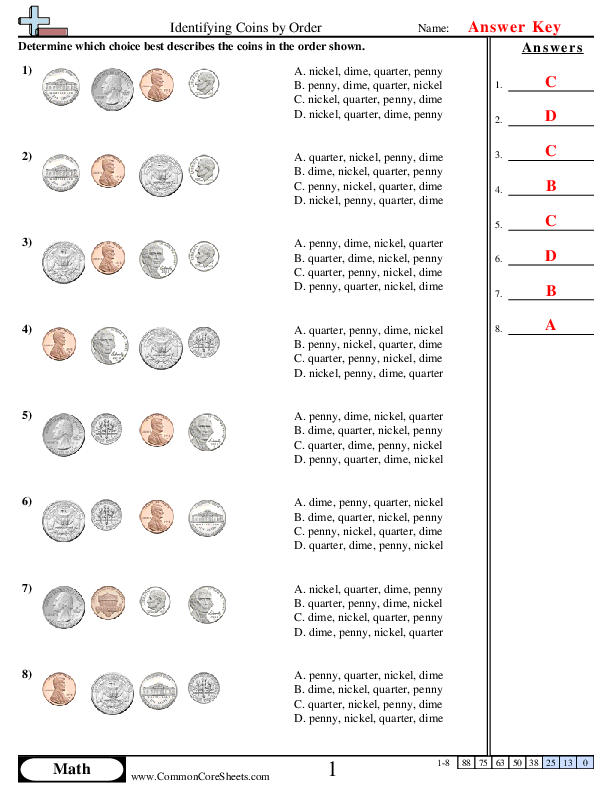
Identifying Coins by Order


×
Description:
"This worksheet is designed to help children grasp the concept of identifying coins in a specified order. It comprises eight interactive math problems involving nickels, dimes, quarters, and pennies. Customizable for individual learning paces, this versatile resource can be converted into flashcards or utilized in distance learning programs to effectively drive home the concept."

×
Student Goals:
Recognition and Differentiation of CoinsStudents will gain proficiency in identifying and differentiating quarters, dimes, nickels, and pennies. The varied order of the coins in each problem stimulates cognitive ability and the recognition of unique characteristics of each coin.Development of Logical ThinkingThis worksheet encourages logical and critical thinking, as students need to associate the coin names to their visual representation. Such process aids in enhancing the analytical skills of the students, which are vital in problem-solving and decision-making activities.Boosting Memory and Recall AbilityBy consistently identifying and ordering the coins, students indirectly improve their memory and recall abilities. The repetition involved in the process assists in securing the information within the long-term memory of the students, which could then be recalled in future exercises effectively.Enhancement of Attention to DetailThe exercise also aids in the enhancement of the students' attention to detail. Identifying and placing different coins in order requires students to pay close attention to their distinctive features and characteristics. This attention to detail can be beneficial in other areas of study and their lives.Understanding of Sequence and OrderAs the worksheet requires students to order the coins, they also learn and understand the concept of sequence and order. It's a crucial concept in mathematics and is beneficial even in day-to-day tasks thus, increasing the student's math literacy and functional skills.Introduction to early Financial LiteracyWhile the primary function of this sheet is to improve mathematical and cognitive skills, students also get an early introduction to financial literacy. They learn the basics of money, which sets a foundation for money management skills that they will need as they grow.


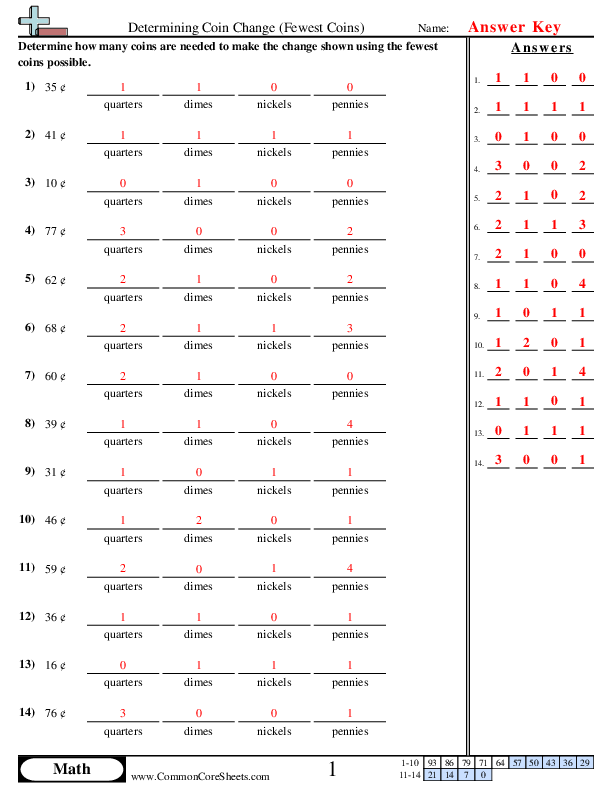
Determining Coin Change (Fewest Coins)


×
Description:
"This worksheet is designed to refine children's math skills by determining the fewest possible coins to equal a cent amount. Featuring 14 problems, pupils will learn coin values, enhancing their counting and problem-solving abilities. Versatile in use, this education tool can be customized to fit individual needs, transformed into flash cards for better retention, or incorporated in distance learning modules. A practical tool to make learning fun and constructive."

×
Student Goals:
Enhanced knowledge of coinsAfter completing this worksheet, students should be able to identify and understand the values of quarters, dimes, nickels, and pennies. They should develop a better knowledge of these coins, their differences, and how they fit in the monetary system. This increased understanding lays the foundation for more advanced financial lessons in the future.Improved mathematical skillsThis worksheet will greatly improve students' mathematical skills. By calculating the fewest coins needed for given amounts, students practice their addition and subtraction abilities, and also grow their problem-solving skills. They learn to deduce, calculate, develop strategies and solve problems, broadening their math capabilities.Adaptability to real world scenariosThe tasks in this worksheet will also help students adapt to real-world scenarios. Knowledge of coins and their values is important in everyday tasks from shopping to understanding bank statements. By learning how to efficiently give and count change, they build a practical skill that will be incredibly useful throughout their lifetime.Focus and attention developmentCompleting this worksheet enhances students' focus and attention to detail. Careful analysis is needed to determine the smallest number of coins to make up a given amount. This encourages a high level of concentration and focus, which are essential components to successful learning and are transferrable to many other subjects.Preparedness for advanced financial lessonsBy mastering the content of this worksheet, students prepare themselves for more advanced financial lessons. Skills such as counting coins make up the base knowledge required to understand complex topics like financial literacy, budgeting, and commerce in the future. This worksheet thus marks an essential step in their financial education journey.


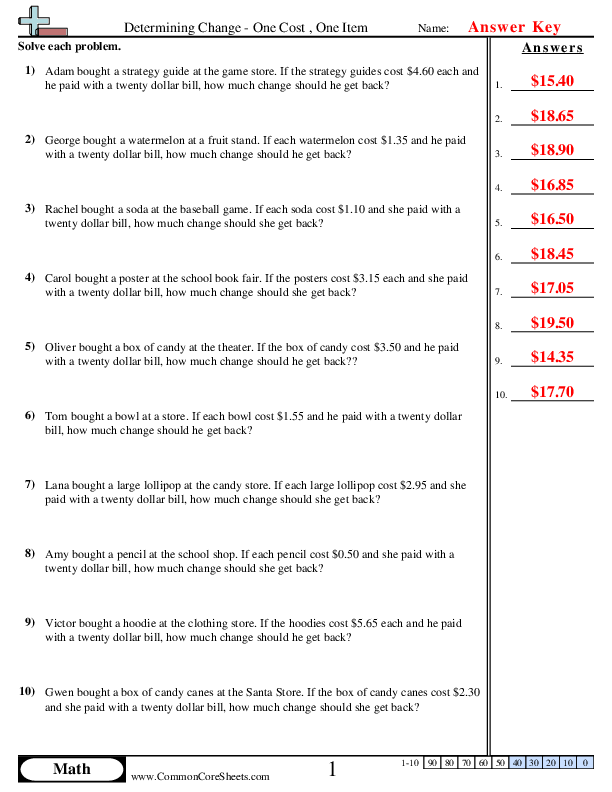
One Item - One Cost
4md2


×
Description:
"This worksheet is designed to engage and enhance children's math skills, specifically in money management and calculations. It contains ten real-world problems that involve determining change from a twenty dollar bill. Customizable for diverse learning styles, it can also be converted into flash cards or utilized for distance learning to adapt to various teaching methods."

×
Student Goals:
Understanding of Mathematical ConceptsAfter completing the worksheet, students should have a stronger grasp on basic mathematical concepts such as subtraction and understanding monetary values. They should be able to comfortably and accurately perform the operation of subtraction to calculate the change that is expected from different transactions. Additionally, they should also understand the value of different denominations of money, and be able to conceptualize what it means to pay for something and receive change.Skills in Practical ApplicationThe students will also gain skills in the practical application of mathematics. The worksheet is designed around real-world scenarios, helping students understand how math applies in everyday life. This should enable them to make the connection between abstract mathematical problems and the application of those mathematical principles in real-life scenarios.Problem Solving and Critical ThinkingSuccess at this worksheet demands critical thinking and problem-solving as well. Students must interpret the problem, break it down into the mathematical operations required, and carry out the calculations correctly. Thus, this practice should help improve their abilities to think critically and approach the problems systematically, enhancing their overall problem-solving skills.Ability to Work IndependentlyCompleting this worksheet helps students develop their ability to work independently. It requires them to understand the problem, decide on the best approach, carry out the necessary steps and verify their answers without direct teacher intervention, thus boosting their confidence in their own abilities to independently tackle and solve problems.Accuracy and Attention to DetailLastly, students will enhance their accuracy and attention to detail. With numerical operations, even a slight miscalculation or overlooking of values can lead to wrong answers. Therefore, this worksheet will train them to closely scrutinize the numbers involved and check their calculations, reinforcing their accuracy and attention to detail in math and beyond.


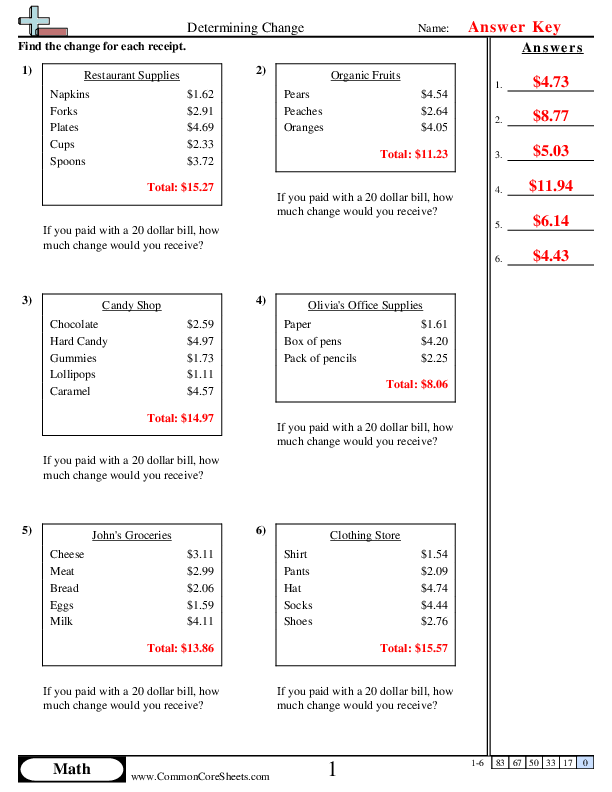
Receipt Change
4md2


×
Description:
"This worksheet is designed to enhance children's understanding of basic math through real-world scenarios. Focused on 'Determining Change,' it offers six practical problems, allowing children to apply subtraction concepts by calculating the change from a $20 bill. Perfect for customizable learning, this worksheet can also be transformed into flash cards or utilized in distance learning settings, promoting active and versatile education."

×
Student Goals:
Understanding the Concept of ChangePost completion of this worksheet, students will gain a solid understanding of the concept of 'change' in monetary transactions. They will understand how to calculate the change that is due when a specific amount of money is used to pay for items worth less than that amount.Enhancing Basic Arithmetic SkillsThis worksheet will provide students with several real-life examples to apply their basic arithmetic skills, particularly subtraction. By determining the change from a twenty-dollar bill in different scenarios, they will enhance their subtraction skills and develop a greater understanding of practical mathematics.Applying Math to Real World ScenariosApplying math to real-world scenarios is a necessary skillset to develop while young. Upon completing the worksheet, students will gain a better understanding of how mathematics principles are applied in everyday situations like shopping. This serves to enhance their ability to use mathematics outside the classroom environment.Improving Problem-Solving SkillsThe worksheet is designed to improve problem-solving skills amongst students. They are presented with a problem – the amount spent and the amount given – and need to work out the solution, which is the change received. This repeated exercise of problem-solving can quickly enhance their analytical and reasoning skills.Cognition of Currency ValueBy undertaking these exercises, students will develop a greater cognition of currency value. As they determine how much money is left after purchases, they understand the value of money and how much different items cost. This reinforces the concept of money value and aids in their financial literacy development.Enhancing Speed and Accuracy in CalculationsThe worksheet provides students the platform to increase their speed and accuracy in doing subtraction problems. Through repetitive practice, students can master these skills which are essential for real-world tasks as well as for a variety of other mathematics problems.


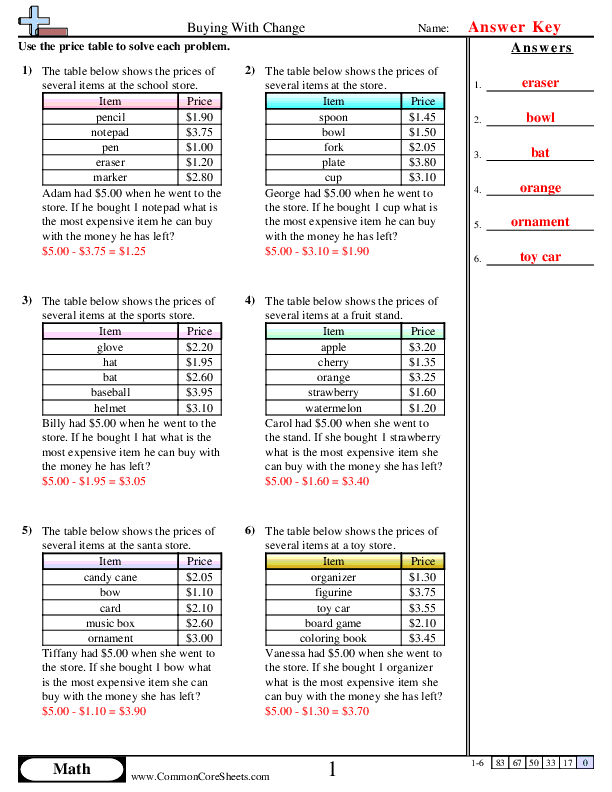
Buying With Change
4md2


×
Description:
"This worksheet is designed to teach children how to manage money by solving practical math problems. It involves pricing scenarios at six different settings, encouraging kids to calculate spending and remaining amount. These math problems can be customized, transformed into flash cards, or utilized in distance learning programs to make learning money management concepts easier and fun."

×
Student Goals:
Understand SubtractionUpon completion of the 'Buying with Change' worksheet, students should have improved their conceptual understanding of subtraction. They will be capable of performing simple subtraction problems independently, which aids in their understanding of everyday mathematics.Enhance Critical ThinkingThis worksheet is designed to help students apply critical thinking skills, as they are required to solve problems that involve making purchasing decisions with a fixed amount of money. Upon completion, learners should be able to determine the cost of items and calculate the remaining money after purchase which also develops their decision-making skills.Money Management SkillsStudents should acquire basic money management skills through this worksheet. They will learn how to plan purchases within a given budget. This important life skill will help them grasp the value of money and the concept of making economical choices.Real-life Math ApplicationStudents get to understand how mathematics is applied in real-life scenarios like shopping at stores. This understanding will be instrumental in helping them see the practical usage of math beyond the classroom.Grasp of Decimal NumbersAs the worksheet employs dollar amounts and change, students should also gain a better understanding of decimal numbers. They will learn how to subtract decimal numbers as well as understand their application in real-life situations like shopping.Problem-Solving SkillsStudents will learn to solve problems based on different scenarios. This will enhance their ability to logically think through problems, arrive at a solution, and solidify their problem-solving skills in diverse situations.


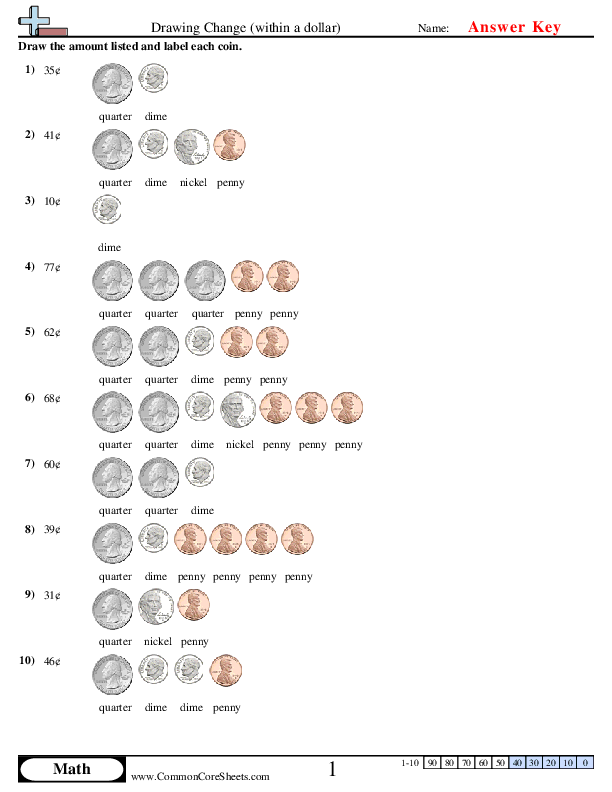
Drawing Change (within a dollar)


×
Description:
"This worksheet is designed to help children enhance their math skills through practice with coins and change. Drawing Change (within a dollar) includes 10 engaging math problems where students need to count and identify quarters, dimes, nickels, and pennies to reach a certain amount. This adaptable resource can be customized to fit any educational setting, transformed into interactive flashcards, or incorporated into distance learning programs to facilitate hands-on learning experiences."

×
Student Goals:
Mathematical ProficiencyUpon completion of this worksheet, students should have improved their mathematical proficiency, specifically within the context of financial literacy. They should be adept at recognizing and understanding the value of different coins such as quarters, dimes, nickels, and pennies and know how to combine them to achieve specific amounts. This will give them a foundational understanding of money management and arithmetic.Problem Solving SkillsDrawing Change worksheet serves as valuable practice in problem-solving. As students find the right combination of coins to match the given amount, they are developing an understanding of how many ways a particular amount can be made. They are enhancing their strategic thinking, reasoning abilities, and logical deduction skills. These skills are fundamental to complex problem-solving and could be applied to diverse areas beyond math.Cognitive AbilitiesSuccessfully completing the exercises will improve learners' cognitive abilities. By working through the problems, students should have improved concrete and abstract reasoning skills. In particular, discerning the coins' value and figuring out how to attain the desired amount with a different coin combination fosters mental agility, sharpness, and number sense. These enhancements in cognitive ability aid in overall academic achievement.Financial LiteracyThe worksheet helps students develop financial literacy at a basic level. Understanding how smaller units of currency (coins) combine to form larger units is a fundamental skill in everyday life. They become familiar with concepts of money, which is instrumental in building a strong foundation for financial management skills that are essential in their future lives.Personal AutonomyCompleting the worksheet promotes the children's personal autonomy. Being able to perform basic money mathematical tasks will give them an appreciation of the fundamental role money plays in society. They start to understand the concept of buying and selling, empowering them to make decisions involving transactions independently. This sense of responsibility aids in their personal growth and maturity.


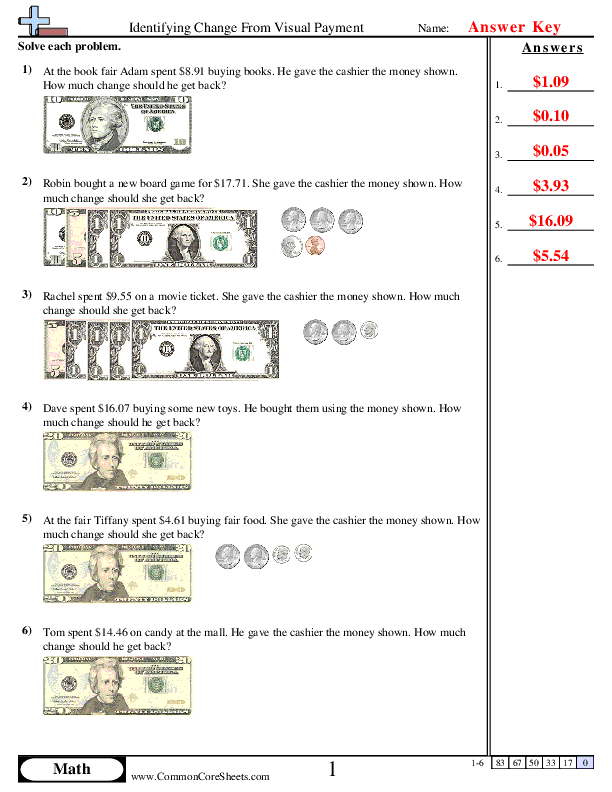
Identifying Change From Visual Payment


×
Description:
This worksheet is designed to help children master the concept of calculating change through real-world scenarios. Providing six unique math problems, it's geared towards enhancing practical money management skills. Its flexible format allows customization, conversion into flash cards, or suitability for distance learning, endorsing versatile educational methods. A hands-on approach to learning, making mathematics more tangible for young learners.

×
Student Goals:
Understanding of Money ValueStudents should enhance their understanding of the value of money. They should be able to quickly identify and understand various monetary denominations such as dollars and cents. This ability will facilitate their daily transactions and comprehension of financial exchanges.Ability to Handle MoneyChildren should develop confidence in handling money independently. Through practical situations depicted in the problems, they should realize the process of giving and receiving correct amounts. Their transactions in the real world would be more smooth and efficient.Performing Basic Arithmetic OperationsStudents should improve their ability to perform basic arithmetic operations, specifically subtraction. Each problem requires the students to subtract the cost of an item from the amount given to the cashier. This practice should strengthen their mathematical skills and promote their cognitive development.Developing Problem-Solving SkillsThis worksheet assists students in developing problem-solving skills. They are presented with scenarios of real-life situations that require mathematical calculations and logical thinking. Over time, they ought to become proficient in given situations, improving not only their problem-solving skills but also their decision-making abilities.Application of Mathematics in Daily LifeStudents should be better able to appreciate the application of math in daily life. This ability is crucial as it helps children understand the importance of math beyond the classroom setting. Their learning becomes more meaningful as they make connections between the classroom learning and real-world applications, thereby nurturing a love for the subject.Understanding of Financial ResponsibilityLastly, the worksheet aims to instil a basic understanding of financial responsibility in children. It makes them more aware of their spending habits, and the importance of noting the change after every monetary transaction. This, in turn, contributes to shaping them into financially responsible individuals in their later life.


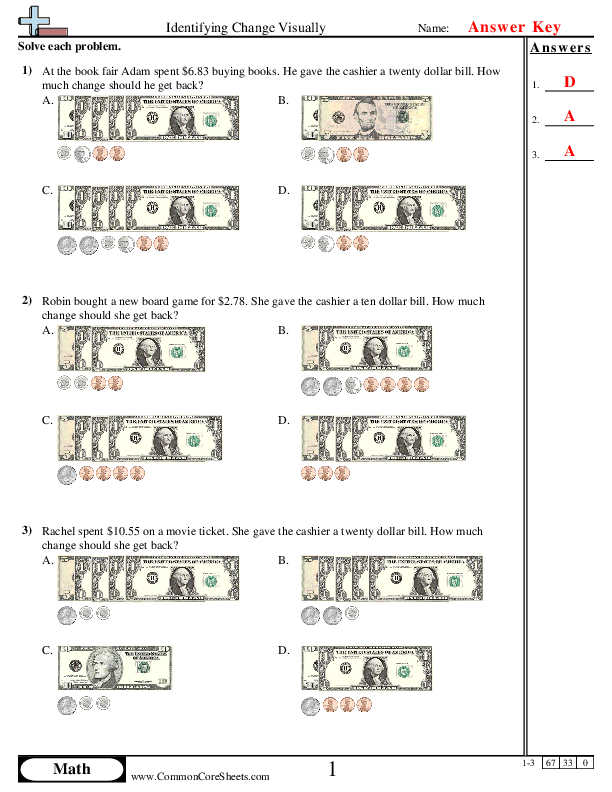
Identifying Change Visually


×
Description:
"This worksheet is designed to teach children the concept of identifying change in math visually, using real-world examples. It contains three problems that depict scenarios at a fair, a book fair, and a mall. These exercises can be customized and converted into flashcards. It's also suitable for distance learning, making it a versatile teaching resource for understanding financial transactions."

×
Student Goals:
Problem-Solving SkillsStudents will gain an understanding of how to effectively approach and solve problems. They will be able to process the given information, identify the question, and use appropriate mathematics operations to find the solution. The specific focus will be on subtracting amounts, which is directly applicable to understanding change in real life transactions.Financial LiteracyLearners will develop basic financial literacy, a vital life skill. By understanding and calculating change for transactions, students will be better prepared for real world situations involving purchases. They will grasp the concept of making payments larger than the cost of a purchase and learn to calculate the change they should receive back.Numerical ProficiencyBy walking through these math problems, students will make progress in their ability to conduct numerical operations, specifically subtraction. They will also further their understanding of decimals, which plays a vital role in managing money and conducting financial transactions. Consequently, learners will be able to handle complex practical math problems with more confidence.Relevance to Real-World ScenariosStudents will learn to apply mathematical concepts to real-world scenarios, in this case, the actual situation of a monetary transaction. This helps to reinforce the relevance and utility of what they are learning, thereby nurturing an appreciation for the practical applications of mathematics.Analytical ThinkingCompleting the worksheet will necessitate the use of analytical thinking skills as learners are not merely applying a formula but also interpreting a narrative problem. This requirement fosters their ability to understand and dissect problems presented in a text-rich format, improving their comprehension capabilities.


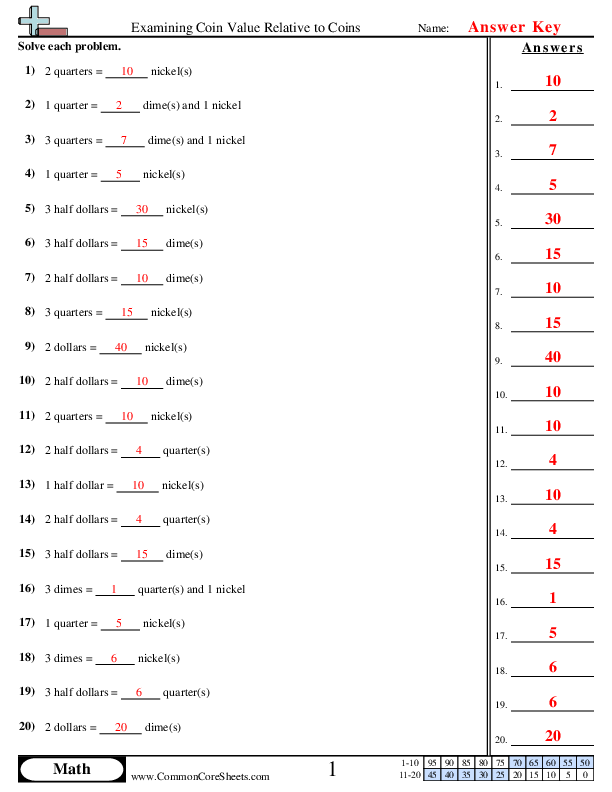
Examining Coin Value Relative to Coins


×
Description:
"This worksheet is designed to instill a strong understanding of coin values in children. The 20 math problems reinforce relations between quarters, dimes, nickels, half dollars, and dollars. It's versatile and can be customized to suit individual learning styles, converted into flashcards for quick review, or utilized as a resource for distance learning. This practical and adaptable tool effectively supports the development of early financial literacy."

×
Student Goals:
Understand Concept of Coin ValuesOn completing this worksheet, students will have gained a strong understanding of the relative value of different coins. They would learn how many of one type of coin is equivalent to another, thereby comprehending the basic principle of coin values in the day-to-day life. Understanding the relative worth of pennies, nickels, dimes, quarters, half-dollars, and dollars will allow them to make correct and confident monetary decisions in real-world situations.Improve Mathematical ProficiencyThe worksheet also helps to improve students' basic arithmetic skills. The ability to quickly and accurately convert between different coin denominations is a fundamental math skill that will also aid in other aspects of mathematical understanding. This activity allows students to practice simple addition, multiplication, and division, which are crucial components in the development of their mathematical proficiency.Enhance Problem-Solving SkillsThese exercises will allow students to enhance their problem-solving skills. They will need to figure out the relationship between different coin values, which involves a level of logical thinking and reasoning. Problem-solving is a universal skill that is used in many areas of life and learning, and this worksheet aids in fostering this skill.Develop Financial LiteracyKnowing the value of coins is the first step towards financial literacy. By practicing such worksheets, students get to inculcate early money management skills. They will learn the importance of each denomination and how they add up to create larger values. This understanding is vital to making wise spending and saving decisions in their future.Boost ConfidenceUpon successful completion of the worksheet, students will feel a sense of achievement boosting their confidence. This will increase their interest in the subject and encourage them to take on more complex problems. Overall, it will help develop a positive attitude towards learning and personal growth.


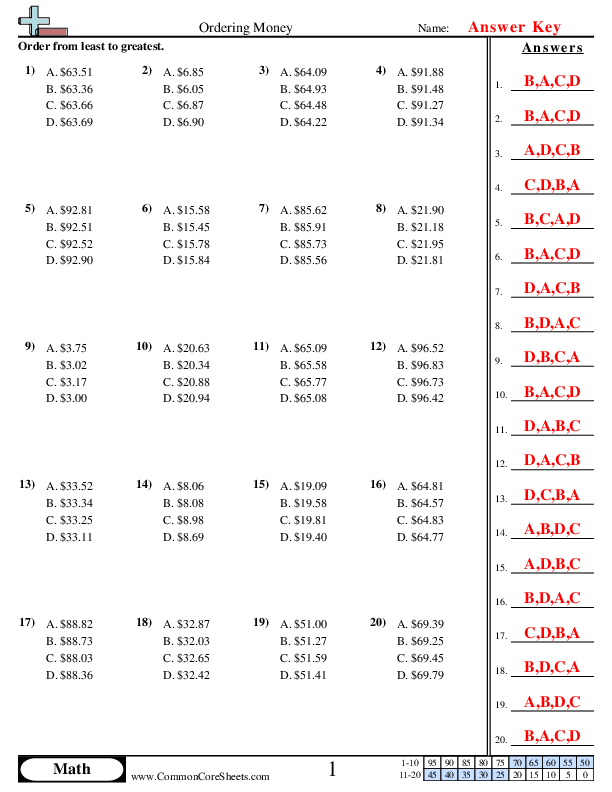
Same dollar amount, different cent amount.
4nf7


×
Description:
"This worksheet is designed to teach children the concept of ordering money values in ascending or descending order. With a total of 20 mathematical problems, it can be customized to suit each child's ability. It's a flexible tool that can be converted into flash cards for in-person exercises or integrated into distance learning programs for an interactive educational experience."

×
Student Goals:
Improved Numerical SkillsUpon completion of the worksheet, students should demonstrate enhanced numerical abilities. They should be confident in identifying sums of money, differentiating between various values, and comparing amounts. This will be especially useful in real-world contexts such as managing personal finances, shopping, and budgeting.Developed Critical Thinking SkillsChildren should be able to exhibit improved critical thinking skills as the worksheet promotes logical reasoning. Through comparing and ordering different amounts of money, students learn to make logical decisions, understand relationships between numbers, and grasp the concept of sequencing. These problem-solving abilities are instrumental not only in mathematical subjects, but across all areas of learning.Enhanced Concentration LevelWorking through the problems in this worksheet can significantly increase students' focus and attention span. The process of evaluating different monetary amounts and determining their correct order requires diligence, precision, and concentration, all of which are important skills for academic success and beyond.Promotion of Independent LearningThe worksheet aids in fostering a learner's independence. As they navigate resolving the problems independently or via minor guidance, they learn to rely more on their judgment, which contributes to their self-efficacy and academic independence. This is a crucial step in becoming lifelong learners.Understanding Mathematics in Daily LifeBy completing the worksheet, students should gain a deeper appreciation of the practical applications of mathematics. They will perceive how math is not a mere abstract concept, but a tool used in daily life scenarios, especially when it comes to dealing with money. This understanding provides essential context to their learning and makes the subject matter more relatable.Incremental LearningLastly, students reinforcing knowledge of smaller amounts of money will be better equipped to handle larger sums in the future, making this not only an exercise in immediate learning, but in gradual skills development as well. Small incremental advancements lead to mastery in a skill, and this worksheet provides just the right platform for said progression.



Different dollar amount, different cent amount.
4nf7


×
Description:
"This worksheet is designed to enhance children's math skills in dealing with monetary values. Featuring 20 practical exercises about ordering money, the worksheet provides real-world problems to reinforce comprehension. Users can customize it to fit various learning styles, convert it into flashcards for interactive training, or utilize it for distance learning. An effective tool for honing numeracy abilities while understanding money's value."

×
Student Goals:
Understanding the Concept of MoneyBy completing the worksheet, students will gain a deeper understanding of the concept of money. This involves recognizing the different denominations and their respective values. They will become familiar with the symbols used for currency and understand the idea of decimal values in money.Ability to Compare AmountsStudents will learn to compare different amounts of money. They will identify which amount is more or less when given multiple choices. This skill is not only necessary for mathematical development but also vital in real-life applications like shopping and budgeting, helping them become more financially literate from an early age.Ordering and Sorting Money ValuesThe worksheet develops students' skills in arranging money values in ascending or descending order. They will learn to efficiently organize numbers and values, improving their numerical understanding and making complex calculations easier in the future.Critical Thinking ImprovementBy finding the correct answer among multiple options, students will improve their critical thinking skills. The process involves analyzing each option, comparing values, and reasoning before reaching a decision. This exercise thus aids in honing critical cognitive competencies, which are beneficial not only in mathematics but across other subject areas.Enhancing Attention to DetailWorking on the worksheet encourages students to be attentive to details. Their proficiency to spot differences among seemingly similar numbers is improved. This is a valuable skill that assists students in spotting errors and correcting them, thereby refining their precision not just in mathematics, but also in day-to-day activities.Boosting Confidence in Handling MoneyUpon successful completion of the worksheet, students will gain confidence in their ability to handle and manage money. Their fear and anxiety related to handling money may decrease, and they might feel more comfortable participating in activities involving monetary transactions, such as school events or personal savings activities.


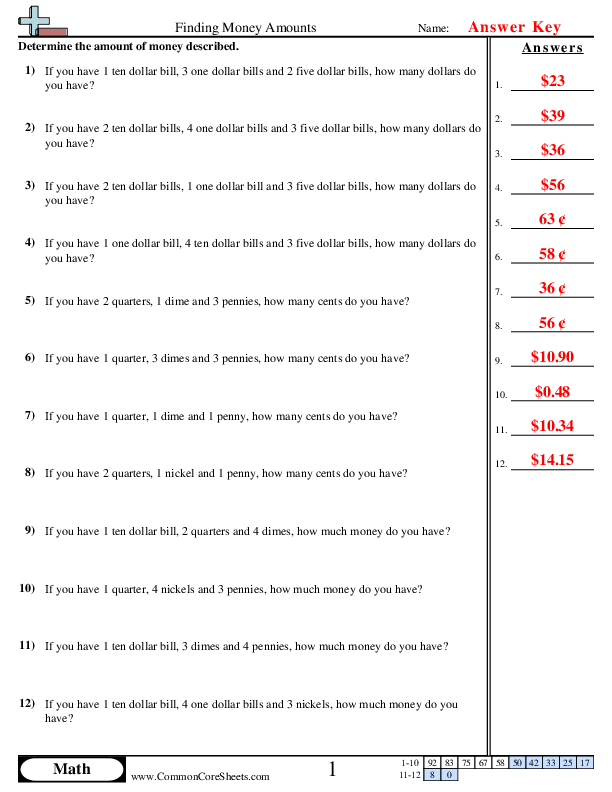
Find Amounts (Dollars and Cents)
2md8


×
Description:
This worksheet is designed to enhance children's math skills, specifically in calculating monetary values. It provides 12 problems that involve summing up different combinations of bills and coins. Customizable for varying learning needs, it can be converted into flash cards or adapted for distance learning environments. Perfect for developing financial literacy from an early age.

×
Student Goals:
Comprehension of Money ConceptsUpon successful completion of the worksheet, students should be able to demonstrate an understanding of basic money concepts. This includes recognizing different denominations of currency in both bill and coin forms, be it pennies, nickels, dimes, quarters, or dollar bills in different values. This will, in turn, enhance their practical knowledge of everyday financial transactions which is a quintessential life skill.Addition and Subtraction ProficiencyThe students should be able to exhibit higher proficiency in addition and subtraction. As the problems encompass calculations that range from simple to complex scenarios, it will help bolster their arithmetic skills and confidence in handling larger numbers. The ability to manipulate numbers is crucial for developing problem-solving and mathematical reasoning skills.Enhancement of Critical Thinking SkillsThe worksheet is designed in a way to stimulate the students' cognitive abilities. The students should be able to accurately calculate total values from different combinations of coins and notes. Therefore, this sheet will assist in developing their critical thinking and mental arithmetic skills.Real-World ApplicationPost completion of this worksheet, students should be well equipped to apply the knowledge gained, to real-life scenarios. Be it calculating change, understanding the concept of savings, or making financial decisions, the student will be able to implement the learned concepts in practical situations.Improvement in Speed and AccuracyThe worksheet entails a total of 12 problems, this will help students to improve their calculation speed along with the accuracy of their results. Repeated practice will ensure that students improve their mathematical fluency, an essential component for success in higher level math.Encourages Independent LearningUpon completion, the students should become more confident in solving math problems independently. This autonomy in learning not only builds self-confidence but also encourages curiosity and interest in exploring more complex mathematical concepts in the future.


Adding and Subtracting Money
Link









